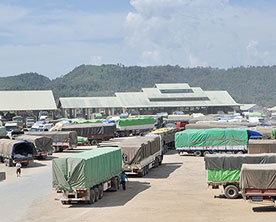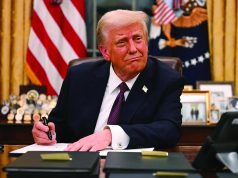A consultation meeting to sign a Memorandum of Understanding (MoU) between the Trade Department under the Ministry of Commerce of Myanmar and the Yunnan Provincial government of China was held at the Union of Myanmar Federation of Chambers of Commerce and Industry (UMFCCI) on May 24.
The MoU is aimed to promote bilateral trade between the two neighbours. Through the planned governmentto-government (G2G) agreement, Myanmar business persons aim to export rice, sugar, corn and other agricultural products to China, while importing agriculture machinery, electronic devices, and iron and steel related materials.
Businessmen from rice, sugar and corn industries raised talks and exchanged views concerning the signing of the MoU, which is scheduled to be inked during the upcoming 5th China-South Asia Expo and 25th China Kunming Import and Export Commodities Fair to be held in China. The expo will take place from June 12 to June 18, 2018. It will run under the theme of “Integrating into the Belt and Road Initiative, Promoting Win-Win Cooperation”.
In addition to the display of commodities from participating countries, the expo will host a series of promotional trade and investment activities namely the China-South Asia Business Forum, the China-Southeast Asia Business Forum, the China-South and Southeast Asia Think Tank Forum, the U.S.-China Sub-National Cooperation Forum and Lancang-Mekong Cooperation Kunming Week.
The UMFCCI stakeholders will collect inputs from the Ministry of Commerce, Ministry of Agriculture, Livestock and Irrigation and Office of the Union Attorney-General for devising the MoU draft, according to the meeting.
Entrepreneurs and merchants from Muse and Mandalay commodity depots attended the discussion, led by Deputy Minister for Commerce Aung Htoo. Matters related to currencies are set to be discussed later with banking operators so as to sell products according to international trading criteria.
The planning of the MoU also came after Zeng Zhong, Vice Secretary-General of the China-ASEAN Expo (CAEXPO) Secretariat, encouraged chambers of commerce and industrial associations in Myanmar to organise buying missions to join the expo with business matching being arranged. The expo will serve an effective platform for Myanmar enterprises and products to tap into the Chinese market and attract foreign capital, he said. The upcoming CAEXPO will be the 15th edition, and is scheduled to take place in Nanning, the capital city of China’s Guangxi Zhuang Autonomous Region, from September 12 to September 15. It will be held under the theme of “Jointly building the 21st Century Maritime Silk Road and the China-ASEAN community of innovation”, according the CAEXPO Secretariat.
Other officials at the CAEXPO Secretariat also said that the September event will bring more opportunities for Myanmar businesses to enhance economic and trade cooperation with China and other countries in the region. China is among the major trading partners of Myanmar, with trade mainly being performed through borders. Myanmar usually trades with China via Muse, Lwejel, Kanpikete, Chinshwehaw and Kengtung border trade camps. According to the Ministry of Commerce, bilateral trade between the two countries amounted to nearly $11 billion in the 2017- 2018 financial year that ended on March 31. The value of bilateral trade with China was seen to hit $10.8 billion in 2016-2017 FY, $10.9 billion in 2015-16 FY, $9.7 billion in 2014- 2015 FY, $7 billion in 2013-2014 FY, $4.95 billion in 2012-2013 FY and $5 billion in 2011-2012 FY.
When it comes to trade, Myanmar performs both normal trade (maritime trade) and border trade. The amount of imports into Myanmar normally surpasses that of exports in normal trade while export volume is bigger than import volume in border trade, according to the figures reported by the Central Statistical Organisation of the country. Apart from China, its other main trading partners are Thailand, India, Japan, Indonesia, Germany and Hong-Kong.
Myanmar has entered into border trade agreements with four out of its five neighbouring countries; China, India, Thailand and Bangladesh. There are a total of 16 border trade posts along the borders namely Muse, Lwejel, Kan Pike Tee, Chinshwehaw, Myawaddy, Tachileik, Kyaingtone, Tamu, Rhi, Myeik, Kawthaung, Htikhee, Mawtaung, Sittwe, Maungdaw and Maesae.
The country’s export structure is largely dominated by natural resources and primary products. It mainly exports agricultural produce and oil and natural gas. Other major exports include forest products, fishery produce, mined products, clothing, rubber and raw materials. It imports consumer products, fuel, industrial machines, capital goods and other value-added products. Myanmar has suffered a serial negative balance of trade in recent years; $92 million for 2012-2013, $2.5 billion for 2013-2014, $4.9 billion for 2014-2015 and $5 billion for 2015- 2016. The lack of ability to produce value-added products largely contributes to the trade deficit situation of Myanmar.
In November last year, China offered a suggestion to Myanmar to construct a new economic corridor between the two neighbours so as to further boost bilateral cooperation. The proposal was made by Chinese Foreign Minister Wang Yi during his visit to Myanmar to attend the Foreign Ministerial Meeting of ASEM, an Asia-Europe political forum to promote relations and various forms of cooperation among the 53 partners. China proposed building the ChinaMyanmar economic corridor in order to form a large cooperation pattern between the two countries as a further move to enhance China-Myanmar comprehensive strategic cooperative partnership, according to Wang Yi.
Myanmar leaders agreed and supported the Chinese suggestion. The proposed corridor starts from China’s Yunnan Province and go down south to the central Myanmar city of Mandalay to continuously extend south to the country’s largest city of Yangon and west to Kyaukphyu in Rakhine state where China’s special economic zone lies, forming a three-pillar giant cooperation pattern. The plan is apparently China’s further effort in a series of its activities in Myanmar to reinforce the implementation of its ambitious Belt and Road Initiative. Myanmar’s strategic location offers a sea gateway to China to access the Bay of Bengal, allowing the big neighbour to find a crucial maritime path in the realisation of China’s trade and development aspirations under the One Belt, One Road (or Belt and Road Initiative) programme.










